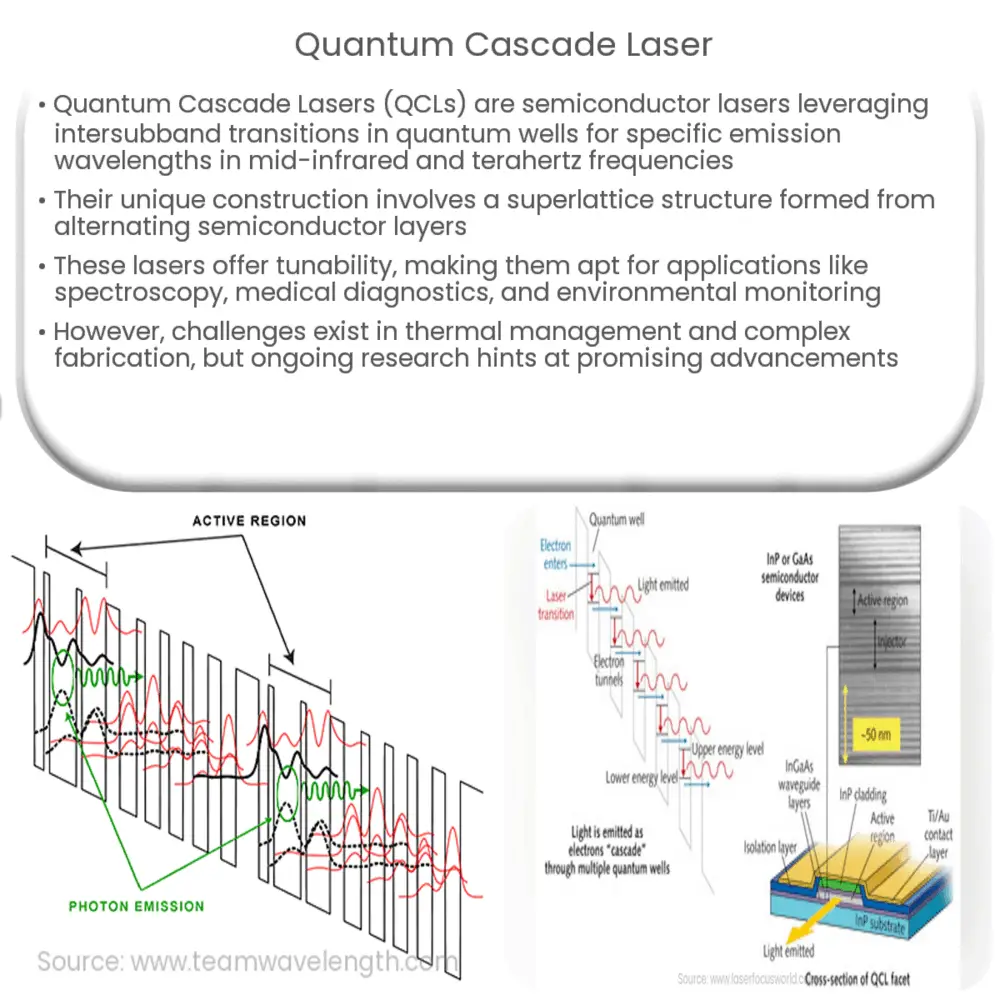Explore Quantum Cascade Lasers (QCLs), their unique operation, construction, applications, challenges, and future prospects.

Introduction to Quantum Cascade Lasers
Quantum Cascade Lasers (QCLs) are unipolar semiconductor lasers that offer significant advantages in the field of infrared spectroscopy. Unlike conventional diode lasers that operate based on the principle of electron-hole recombination, QCLs function via intersubband transitions in a carefully engineered quantum well structure.
Concept and Functioning of QCLs
The fundamental operation of QCLs is based on quantum mechanics. By engineering the size of the quantum wells, the energy difference between the subbands can be precisely controlled. This allows for the production of lasers with specific emission wavelengths in the mid-infrared and terahertz frequency range. The electrons in the QCLs undergo transitions between these subbands, which in turn produces photons with the corresponding energy, leading to laser emission.
- Quantum Wells: These are thin layers where the motion of electrons is confined in one dimension. This confinement leads to the creation of discrete energy levels or subbands.
- Intersubband Transitions: These are transitions between the different energy levels within a quantum well. In QCLs, these transitions are used to produce photons.
One of the significant advantages of QCLs is their tunability. By adjusting the quantum well dimensions, the emission wavelength of the laser can be finely tuned, making QCLs suitable for a wide range of applications.
Construction of Quantum Cascade Lasers
The construction of a QCL involves layering different semiconductor materials to create a superlattice structure. This superlattice is composed of alternating layers of high and low bandgap materials, forming the quantum wells and barriers. The thickness of these layers is precisely controlled at the atomic level during manufacturing using techniques such as Molecular Beam Epitaxy (MBE) or Metal Organic Chemical Vapour Deposition (MOCVD).
- Superlattice: This is a structure that is formed by stacking alternating layers of two different semiconductor materials. In QCLs, the superlattice forms the quantum wells and barriers.
- Molecular Beam Epitaxy (MBE): This is a method used in the fabrication of semiconductor devices. It allows for precise control of layer thickness at the atomic level.
- Metal Organic Chemical Vapour Deposition (MOCVD): This is another technique used in semiconductor device fabrication. It is particularly useful in the creation of multilayer structures like the superlattice in QCLs.
The electrons in the QCL are injected into the upper subband of the quantum well and then cascade down through the subbands, emitting a photon at each transition. This process gives the Quantum Cascade Laser its name.
Applications of Quantum Cascade Lasers
Due to their unique operating principles and tunable emission wavelengths, Quantum Cascade Lasers find applications in a plethora of fields:
- Spectroscopy: QCLs are extensively used in infrared and terahertz spectroscopy. Their tunability allows them to be used for the detection of a variety of chemicals and gases.
- Medical Diagnostics: Non-invasive medical diagnostics is another area where QCLs have shown great potential. They can be used for breath analysis to detect biomarkers for certain diseases.
- Environmental Monitoring: QCLs can be used for environmental monitoring, such as detecting greenhouse gases, pollutants, or hazardous substances.
- Free-space Communications: QCLs can be used for free-space optical communications, particularly in the infrared spectrum, due to their high power and stability.
Limitations and Future Prospects
Despite the various advantages and applications, Quantum Cascade Lasers are not devoid of challenges. The primary limitation is related to their thermal management. As QCLs operate based on intersubband transitions, they do not benefit from the cooling effect of electron-hole recombination, as observed in conventional lasers. Therefore, efficient heat dissipation mechanisms are crucial for their functioning.
Moreover, the fabrication of QCLs involves complex manufacturing techniques requiring precision at the atomic level. This complexity can potentially impact the scalability and cost-effectiveness of QCL-based systems.
Nonetheless, with advances in material science and nanofabrication techniques, the performance of QCLs is expected to improve, leading to their increased adoption in various sectors. Research in QCL technology is vibrant and ongoing, promising potential breakthroughs and enhancements.
Conclusion
In summary, Quantum Cascade Lasers represent a significant advancement in semiconductor laser technology. Their unique operating principles, based on quantum mechanics and intersubband transitions, provide them with a high degree of tunability and enable their use in a wide range of applications. While there are challenges related to their thermal management and complex manufacturing, ongoing research and development promise to mitigate these limitations and unlock even broader applications for this remarkable technology.

